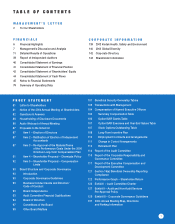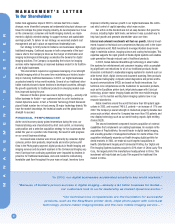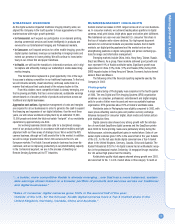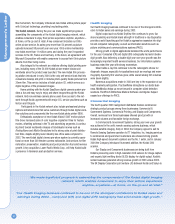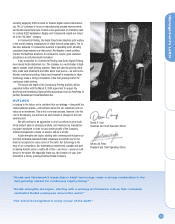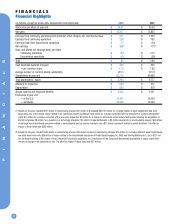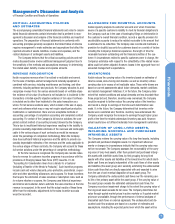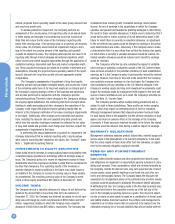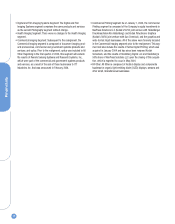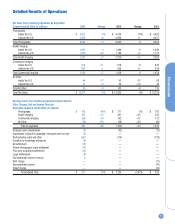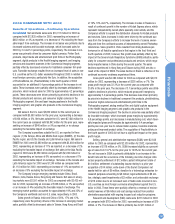Kodak 2003 Annual Report Download - page 3
Download and view the complete annual report
Please find page 3 of the 2003 Kodak annual report below. You can navigate through the pages in the report by either clicking on the pages listed below, or by using the keyword search tool below to find specific information within the annual report.
Management’s Letter
3
STRATEGIC OVERVIEW
As the digital evolution impacted traditional imaging industry-wide, we
aligned the Company in the fourth quarter to focus aggressively on three
market sectors with major growth potential:
• In Commercial, we’ll expand our participation in on-demand printing,
develop commercial services and invest intelligently in products and
services for our Entertainment Imaging and Professional markets.
• In Consumer, we’ll expand services for online mobile imaging, grow the
digital capture business, leverage our leadership in imaging kiosks and
extend our presence in home printing. We will continue to invest selec-
tively in our critical film and paper franchises.
• In Health, we will lead the transition to information services, win in digi-
tal capture and efficiently manage our leadership in media-based diag-
nostics imaging.
This transformation represents a great opportunity. One of the keys
to success is staying competitive in our traditional businesses. To that end,
we will innovate smartly, invest selectively, and keep costs down in a
manner that reduces fixed costs ahead of the volume decline in film.
From this a bolder, more competitive Kodak is already emerging, one
that is growing profitably, that has a more balanced, sustainable earnings
stream based on a broader portfolio of products and services across our
traditional and digital businesses.
Aggressive cost actions. Aggressive management of costs and margins
are required for all our businesses in order to generate the cash to support
the financing and expansion of our digital initiatives. Over the next three
years, we will reduce worldwide employment by an estimated 12,000-
15,000 people and shrink the total real estate “footprint” of our worldwide
operations by approximately one-third.
Our evolving business climate also calls for a disciplined manage-
ment of our product portfolio in accordance with market realities and tight
alignment with our three areas of strategic focus. We’ve exited the APS
camera business, athough we’ll still provide film to the market. In addition,
we will no longer provide Kodak 35mm film cameras to the U.S. and
European markets. The Kodak Carousel projector business has been dis-
continued, and we’re improving productivity in our photofinishing capacity.
In the Commercial segment, we are in the process of divesting our
Remote Sensing Systems unit to ITT Industries.
BUSINESS/MARKET HIGHLIGHTS
Kodak’s market successes in 2003 ranged across all of our core business-
es. In consumer markets, we achieved leading share positions in digital
cameras, retail print kiosks, inkjet photo paper and online print fulfillment.
We maintained our year-over-year blended U.S. consumer film share in
the face of industry-wide volume declines. Our high-speed document
scanners for commercial markets are perennial leaders. And in health
markets, our digital printing systems lead the market and we have
strengthening positions in digital radiography and picture archiving sys-
tems for image and information management.
Emerging markets include China, India, Hong Kong, Taiwan, Russia,
Brazil and Mexico. As a group, these markets achieved good growth and
now represent 19% of Kodak worldwide sales. Significant growth was
experienced in China (12%), India (17%) and Russia (26%) during 2003.
SARS impacted sales in Hong Kong and Taiwan. Economic factors slowed
sales in Brazil and Mexico.
The following reflect the financial reporting segments used by the
Company in 2003:
Photography
A major restructuring of Photography was completed in the fourth quarter
of 2003. The new Digital and Film Imaging Systems (DFIS) organization
combines our consumer, professional, entertainment and digital imaging
units to create a flatter, more focused and more accountable business
organization. DFIS generates about 70% of Kodak’s worldwide sales.
Worldwide sales in Photography rose slightly compared to 2002, with
lower prices offsetting volume gains and positive currency exchange.
Volumes increased for consumer digital, inkjet media and motion picture
print distribution films.
Digital camera sales showed very strong growth with the introduc-
tion of new Kodak EasyShare digital cameras and the EasyShare printer
dock 6000 for home printing. Sales were particularly strong during the
holiday season, achieving significant gains in market share. Sales of con-
sumer digital cameras grew 130% in the second half of the year. Outside
of the U.S., for the full year, Kodak digital cameras have a Top 4 market
share in the United Kingdom, Germany, Canada, China and Australia. The
Kodak Professional DCS Pro 14n digital camera had an enthusiastic recep-
tion in the professional market. Delivering 14 megapixel image resolution,
the 14n earned high praise from the industry.
Kodak photo-quality inkjet papers showed strong growth over 2002,
and were tied for No. 1 in U.S. market share in this category. To build on
“…a bolder, more competitive Kodak is already emerging… one that has a more balanced, sustain-
able earnings stream based on a broader portfolio of products and services across our traditional
and digital businesses.”
“Sales of consumer digital cameras grew 130% in the second half of the year.
Outside of the U.S., for the full year, Kodak digital cameras have a Top 4 market share in the
United Kingdom, Germany, Canada, China and Australia.”

